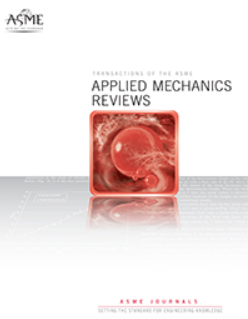Shear Deterioration of the Hierarchical Structure of Cellulose Microfibrils under Water Condition: All-Atom Molecular Dynamics Analysis
IF 16.1
1区 工程技术
Q1 MECHANICS
引用次数: 0
Abstract
This study aims to understand the mechanical properties of cellulose nanofibers (CNFs), a nano-sized material element of woods or plants. We develop all-atom (AA) molecular dynamics models of cellulose microfibrils (CMFs), which are the smallest constituent of CNFs. The models were designed for the process of structural failure or the degradation of a hierarchical material of multiple CMF fibers, due to shear deformation. It was assumed that two CMFs were arranged in parallel and in close contact, either in a vacuum or in water. The CMF models in water were built by surrounding AA-modeled water molecules with a few nanometers. Shear deformation was applied in the axial direction of the CMF or in the direction parallel to molecular sheets. Shear moduli were measured, and they agree with previous experimental and computational values. The presence of water molecules reduced the elastic modulus, because of the behavior of water molecules at the interface between CMFs as a function of temperature. In the inelastic region, the CMF often broke down inside CMFs in a vacuum condition. However, in water environments, two CMFs tend to slip away from each other at the interface. Water molecules act like a lubricant between multiple CMFs and promote smooth sliding.水条件下纤维素微原纤维层次结构的剪切劣化:全原子分子动力学分析
本研究旨在了解纤维素纳米纤维(CNFs)的力学性能,这是一种纳米级的木材或植物材料元素。我们建立了纤维素微原纤维(CMFs)的全原子(AA)分子动力学模型,它是纤维素微原纤维的最小组成部分。这些模型是为结构破坏或多层CMF纤维分层材料由于剪切变形而退化的过程而设计的。假设两个CMFs在真空或水中平行排列并紧密接触。通过将aa模型水分子包裹几纳米,建立了水中CMF模型。在CMF轴向或平行于分子片方向施加剪切变形。对剪切模量进行了测量,结果与以往的实验值和计算值一致。水分子的存在降低了弹性模量,因为水分子在CMFs界面上的行为是温度的函数。在非弹性区,在真空条件下,CMF内部经常发生破坏。然而,在水环境中,两个CMFs倾向于在界面处相互滑动。水分子就像多个CMFs之间的润滑剂,促进平滑滑动。
本文章由计算机程序翻译,如有差异,请以英文原文为准。
求助全文
约1分钟内获得全文
求助全文
来源期刊
CiteScore
28.20
自引率
0.70%
发文量
13
审稿时长
>12 weeks
期刊介绍:
Applied Mechanics Reviews (AMR) is an international review journal that serves as a premier venue for dissemination of material across all subdisciplines of applied mechanics and engineering science, including fluid and solid mechanics, heat transfer, dynamics and vibration, and applications.AMR provides an archival repository for state-of-the-art and retrospective survey articles and reviews of research areas and curricular developments. The journal invites commentary on research and education policy in different countries. The journal also invites original tutorial and educational material in applied mechanics targeting non-specialist audiences, including undergraduate and K-12 students.

 求助内容:
求助内容: 应助结果提醒方式:
应助结果提醒方式:


